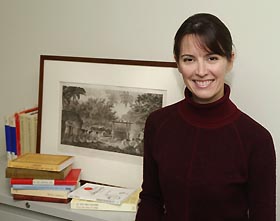|
This is an archived article.
For the latest news, go to the Advance
Homepage
For more archives, go to the Advance Archive/Search Page. |
||
|
D'Alleva Studies Class, Gender
In Tahitian Art
By Sherry Fisher It wouldn't be unusual to find Anne D'Alleva sifting through dusty boxes and drawers in a museum's storage room. In fact, her research has taken her to many museums around the world, where she does just that. "I'm always hunting for the stuff that nobody else is looking at," says the associate professor of art history and women's studies.
D'Alleva, a fellow at the University of Connecticut Humanities Institute this year, studies late 18th- and early 19th-century Tahitian art, with an emphasis on class and gender issues. Cultural Changes
Cook brought back texts, descriptions, and images drawn by artists and an enormous collection of island artifacts that captured the imaginations of Europeans, D'Alleva says. "One of the things that emerged was the idea of the exotic, sensual island woman that we still have today in some form - the myth of the Tahitian dancing girl. "They weren't just the pretty young girls that Cook and his officers portrayed," D'Alleva says. "When you read through the sources, you find that they were high-ranking women, wrapped in enormous costumes, displaying the wealth of their lineage. The 'hura' dance, similar to Hawaiian hula, is not about sensuality; it's about family, genealogy and lineage." Women and Politics
"They were politically powerful," she says. "They were diplomats. They were dynamic, intelligent, ambitious women, different from the images we carry around of sensual, passive women." D'Alleva's study of cloth made by Tahitian women from the bark of mulberry trees has offered new insight into Tahitian values. "These cloths have been pretty much neglected in Western accounts of Tahitian culture," she says, "but were very important in diplomatic exchanges. It was a women's art form and the cloths have great social and religious significance." Whether she is examining the patterns on a piece of bark cloth or studying a piece of sculpture, she always asks the same questions: What does it mean? Why was it collected? Who gave it away? Was it valuable to them? Why was it given away? What kinds of things did it convey when it got to Europe? A particularly striking find, says D'Alleva, was finely braided human hair. "I started to read about it in Cook's journals. He wrote about one braid that was a mile and a half long. It turns out these braids were made by high-ranking women from their own hair or the hair of relatives, and exchanged on very important occasions." Humanities Fellow
D'Alleva earned a bachelor's degree in art history from Harvard in 1986 and a Ph.D. in art history from Columbia in 1997. At Columbia, she was the first student to complete the Graduate Certificate in Feminist Theory from the Center for Research on Women and Gender. Her doctoral dissertation, which explored gender and the visual arts in Tahiti during the time of European contact, was the first such full-length study of any Pacific culture. It is now a book manuscript under review.
|

